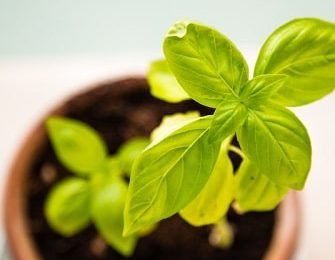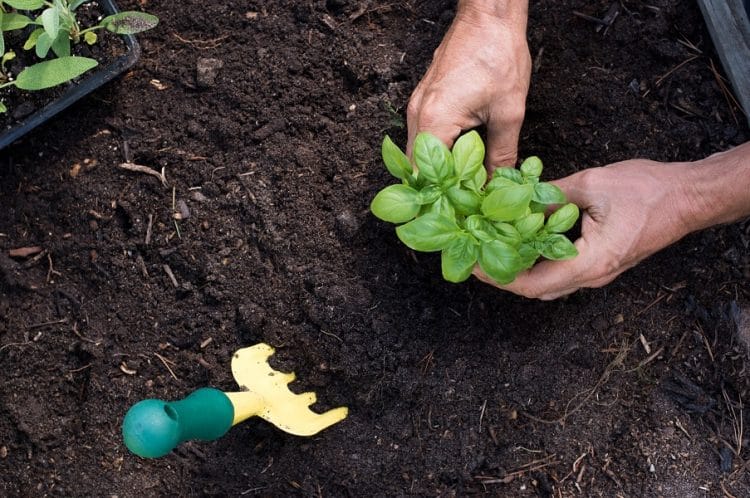Basil Growing Guide at Home Garden
Fragrant, flavourful and fair of foliage, this herb is a feast for the senses
Where and How to Grow Basil
Basil stands first among the “warm” herbs, those with such highly volatile oils that a mere brush against the foliage releases a burst of fragrance. It’s a member of the mint family (Lamiaceae) and shares mint’s characteristic square stems, preference for moisture, and lush growth in rich organic soil with good drainage.
My first vegetable garden was a municipal allotment with access to a mountain of composted manure from the local zoo. Fed liberally from this wealth of zoo-poo (mostly elephant and lion), the basil grew to jungle-sized stature. (That year I could have stuffed my pillows with it!) The herb’s essential oils produce their most luscious scent and flavor when fed with natural fertilizers; incorporate garden compost and composted manure into the bed or container to produce superior plants.
Basil grows best in a cool location with part shade to full sun and consistent moisture; it quickly wilts in hot, dry weather, causing loss of flavor and permanently stunted plants. Manure and compost supply the trace elements essential to basil’s flavor; feed with a water-soluble fertilizer every two to three weeks to maintain new leaf production. Harvest leaves individually or takes sections of the stem, leaving at least 15 centimeters and three sets of leaf nodes behind. New stems will sprout rapidly. Pinch off flower buds to extend leaf production, or allow them to grow and provide a happy feast for pollinators.
Sweet Basil Herbs
Sweet basil (Ocimum basilicum, 60 cm) is the most familiar plant, with slightly puckered leaves and white flowers. The eight-centimeter leaves of ‘Sweet Genovese’ and ‘Di Genova’ are perfect for pesto-making; enhance the flavor by including leaves of ‘Thai Siam Queen’, a purple-flowering variety with stronger flavor and fragrance.
To produce a large supply of pesto, the crinkly leaves of ‘Lettuce Leaf’ and ‘Napoletano’ are the largest, lime green and beautiful. Dwarf basil (O. b. ‘Minimum’, 20 to 30 cm) forms dome-shaped mounds with tiny, tasty leaves topped by white flowers. ‘Spicy Globe’, ‘Minette’, ‘Marseillais Dwarf’, and ‘Green Bouquet’ grow into rounded shapes perfect for clay pots or edging a bed.
Purple-Leafed Basils
Purple-leafed basils (O. b. purpurescens, 40 to 60 cm) are prized for their flavor, vivid coloring, and leaf form. With flowers from bright pink to purple, the leaves are plain to ruffle or deeply cut burgundy-purple. Flat-leafed ‘Dark Opal’ and ‘Osmin Purple’, puckered ‘Red Rubin’ and frilly ‘Purple Ruffles’ make striking displays in a large clump by themselves, or mixed with other herbs and annuals.
Scented basils (O. b. citriodorum, O. americanum) combine the herb’s basic anise-mint-clove flavor with undertones of lemon, lime, and cinnamon. The heirloom variety ‘Mrs. Burns’ Lemon’ is intensely flavored, and has six-centimeter leaves and white flowers.
Hybridizers have bred edible ornamental plants, aiming for rounded, compact forms with flat tops carrying white, maroon, or purple flowers. The blooms of new basil hybrids are carried on shorter inflorescences—10 to 13 whorls of six flowers tightly arranged along each rachis (spike)—that cover the dark green foliage for several weeks. Early- and late-maturing varieties allow for an extended season of blooms (plants will re-flower if first blossoms are removed).
Hybrids can be grown from seed, and include ‘Lemon Sweet Dani’ (65 cm); compact ‘Magical Michael’ (25 to 35 cm), with red-veined leaves and stems and fragrant burgundy flowers; and ‘Thai Magic’ (30 to 45 cm), with green leaves and purple stems and flowers. They are magical plants in every respect, and a pot outside your door is sure to attract desirable attention.
More About its Flavor and History
Chemistry Class
Basil lovers are devoted to its minty anise flavor and revel in the summer months when their favorite herb is fresh from the garden. And as in all affairs of the heart and stomach, chemistry is a strong influence over the sensory passions. The predominant element in basil’s essential oil is linalool, terpene alcohol with a pleasant taste combined with minty methyl chavicol and clove-like eugenol.
Terpenes are hydrocarbons found in the essential oils of plants, and their strong scent is also detected in lavender and pinewood. Terpenoids in basil are important anti-cancer phytochemicals—naturally occurring substances that work in conjunction with vitamins and other food nutrients to stimulate protective enzymes and block metabolic pathways associated with the development of cancer and heart disease.
First Aid
Fusarium Wilt Seeds of sweet basil—and its cousin, mint—sometimes carry fusarium wilt (Fusarium oxysporum) spores. Once the ground in which the spores grow becomes infected, the spores proliferate and cause young plants to wilt when seedlings reach 15 to 30 centimeters tall. Symptoms are brown streaks and discolored tissue on stems, and sudden leaf drops. There’s no chemical treatment for fusarium wilt, but you can avoid it by growing resistant ‘Nufar Hybrid’. If the disease strikes, don’t plant basil in that location for several years.
Slugs and snails These pests love the flavor of basil and will search out tender leaves after dark. All the slug-catching methods can be applied to the basil patch, but don’t use any chemical slug baits around food plants. Overturned grapefruit rinds and beer traps are useful, and a generous sprinkling of powdered sulfur around the plants will discourage slugs and snails. Nighttime inspections with a flashlight and salt cellar are the most successful method.
Ancient History
Ancient forms of basil originated in Africa and India and are still available. African tree basil (Ocimum gratissimum), sometimes called shrubby or clove basil is a pungently scented sub-shrub with slightly hairy leaves and delicate white to yellow-green, two-lipped flowers that are tasty in salads. It’s a handsomely imposing plant more than one meter tall when container-grown.
For medicinal purposes, Africans turn to camphor basil (O. kilimandscharicum), chewing the leaves to release the antibiotic and anesthetic elements. Many of the older species are perennials, hardy to Zone 10 in tropical climates, and ideal as fragrant, edible indoor plants in sunny northern windows. Households in India have a traditional pot of red- or green-leafed Tulasi, or holy basil (O. tenuiflorum), dedicated to the Hindu gods Vishnu and Krishna. Chewing a leaf of holy basil each day is thought to ward off evil spirits and preserve health. Holy basil is believed to guarantee safe passage to heaven, and mourners cast the leaves into graves to ensure the blessing.
Growing Basil – Basil is Most Versatile Herb
 Of all the herbs that can be grown successfully in USA gardens, basil is likely the most versatile. Basil can be used as a showy ornamental, it’s fragrance and flowers are great in fresh flower bouquets and, of course, there are some very delicious culinary creations enhanced by the awesome taste of this easily grown garden herb.
Of all the herbs that can be grown successfully in USA gardens, basil is likely the most versatile. Basil can be used as a showy ornamental, it’s fragrance and flowers are great in fresh flower bouquets and, of course, there are some very delicious culinary creations enhanced by the awesome taste of this easily grown garden herb.
Gardeners who are experienced at growing herbs know that there are quite a few choices of basil that could easily fill up the garden and the landscape. There are four delightful groups of basil to choose from that include sweet green basil, dwarf green basil, purple-leaved basil, and scented leaf basil. It’s easy to get caught up in basil-mania once you start to explore all the possible cultivars and their attractive characteristics.
Sweet basil usually grows to about 24 inches. The leaves of sweet basil are 2 – 3 inches long and it produces white flower spikes. Genovese basil and spicy Thai basil, ‘Siam Queen’ (AAS 1997 winner) are part of this group.
Dwarf basil grows to about 12 inches tall with 1/2 inch leaves and white flowers. ‘Spicy Globe’ and ‘Green Bouquet’ are two well-known dwarf varieties.
Scented-leaf basil brings an additional aroma to the garden. One of these, lemon basil, actually has a very distinct lemon flavor. Lemon basil ‘Sweet Dani’ is a 1998 AAS winner. The leaves are grayish-green and the flowers are white. Two others to consider are cinnamon basil and anise basil. Cinnamon basil has a spicy cinnamon flavor and pink flowers with purple bracts. Anise basil is licorice-flavored and purple-flowered.
Purple-leaved basils are considered very ornamental but are also quite edible. The purple leaves are ruffled, frilled, or deeply cut and flower spikes produce showy deep pink to lavender-purple flowers. Some of the more popular varieties have names like ‘Purple Ruffles’, ‘Red Rubin’, and ‘Dark Opal’. ‘Purple Ruffles’ is a 1987 AAS winner.
Basil can easily be sown directly in warm garden soil after nighttime temperatures are 55 degrees consistently. Select a sunny, well-drained site. Add a little organic matter if the soil is very sandy. Seeds should sprout quickly. When plants are about 4 inches tall, give them their first pinch to increase branching. For dwarf basils, thin seedlings to about 12 inches apart. For the larger growing varieties, thin to about 30 inches apart.
When harvesting basil for the kitchen, cut entire stems. What isn’t used fresh is easily dried and will store all winter. For best flavor, harvest before flowering begins. However, basil makes an excellent cut flower by itself, with other basils or with a mixed bouquet from the flower garden.
As you are planning this year’s garden consider adding one or several basils. The easy-to-grow basils at home add beauty and flavor to USA gardens.
Growing Basil… it’s So Easy
Basil’s pungent flavor enhances any summer garden recipe. And you can choose from lots of varieties, including lemon, cinnamon, and anise-flavored types. Basil also comes in a variety of shapes and colors; you can plant varieties that are low-growing, stocky, or tall, with variegated, crinkled, purple, green, or smooth leaves. The plants can grow up to 2 feet tall and 8 inches wide.
Basil Growing Mini-Guide
- Soil preparation: You can grow basil at home in any well-drained soil amended with plenty of organic matter.
- Planting: Make sure you plant basil where it will get full sun. Start basil seeds indoors 6 weeks before your last expected frost. Plant the transplants outdoors after the danger of frost has passed and when soil temperature averages 50°F or higher.
- Spacing: If you’re growing small-leaved basil, place the plants 6 to 8 inches apart. Varieties with large leaves need 1 to 1½ feet between plants.
- Special hint: Mulching the area after the seedlings have shot up helps to keep the ground moist and warm and discourages weeds. But make sure you mulch after the ground has warmed up because basil roots need heat.
Harvesting Hints
Begin harvesting basil as soon as the plants have several pairs of leaves. If you harvest frequently, you’ll help encourage your plants to produce new growth—which, in turn, will give you, even more, basil to harvest. You can keep harvesting basil up until the first frost. After harvesting, wrap dry foliage in paper towels and store it in resealable plastic bags in the fridge.
Trivia Tidbits
In Italy, basil has been and still is a sign of love. According to tradition, if a man gives a woman a sprig of basil, she will fall in love with him and never leave him. Today, he’d probably have better luck if he made her pesto and served it over pasta with salad, bread, and a little wine—and then did the dishes afterward.
you can buy Basil Plants from Amazon Store here:










